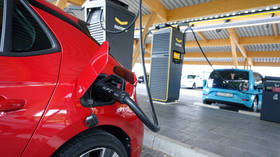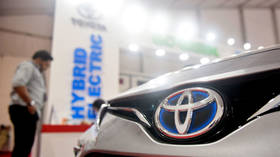World's Largest Offshore Wind System Developer Abandons Two Major US Projects as Wind Bust Continues
https://www.windtaskforce.org/profiles/blogs/world-s-largest-offsho...
.
Wind/Solar/Battery/EV Bubble Crashing
Take a look at iShares Global Clean Energy ETF versus the Nasdaq... Whoops!
Exchange Traded Funds, ETFs, for renewables were down about 40% this year, while the NASDAQ was up about 40%
.

.
APPENDIX 1
Floating Offshore Wind Systems in the Impoverished State of Maine
https://www.windtaskforce.org/profiles/blogs/floating-offshore-wind...
World Offshore Wind Capacity Placed on Operation in 2021
During 2021, worldwide offshore wind capacity placed in operation was 17,398 MW, of which China 13,790 MW, and the rest of the world 3,608 MW, of which UK 1,855 MW; Vietnam 643 MW; Denmark 604 MW; Netherlands 402 MW; Taiwan 109 MW
Of the 17,398 MW, just 57.1 MW was floating, about 1/3%
At end of 2021, 50,623 MW was in operation, of which just 123.4 MW was floating, about 1/4%
https://www.energy.gov/eere/wind/articles/offshore-wind-market-repo...
Despite the meager floating offshore MW in the world, pro-wind politicians, bureaucrats, etc., aided and abetted by the lapdog Main Media and "academia/think tanks", in the impoverished State of Maine, continue to fantasize about building 3,000 MW of 850-ft-tall floating offshore wind turbines by 2040!!
Maine government bureaucrats, etc., in a world of their own climate-fighting fantasies, want to have about 3,000 MW of floating wind turbines by 2040; a most expensive, totally unrealistic goal, that would further impoverish the already-poor State of Maine for many decades.
Those bureaucrats, etc., would help fatten the lucrative, 20-y, tax-shelters of mostly out-of-state, multi-millionaire, wind-subsidy chasers, who likely have minimal regard for:
1) Impacts on the environment and the fishing and tourist industries of Maine, and
2) Already-overstressed, over-taxed, over-regulated Maine ratepayers and taxpayers, who are trying to make ends meet in a near-zero, real-growth economy.
Those fishery-destroying, 850-ft-tall floaters, with 24/7365 strobe lights, visible 30 miles from any shore, would cost at least $7,500/ installed kW, or at least $22.5 billion, if built in 2023 (more after 2023)
See below Norwegian floating offshore cost of $8,300/installed kW
Almost the entire supply of the Maine projects would be designed and made in Europe, then transported across the Atlantic Ocean, in specialized ships, also designed and made in Europe, then unloaded at the Maine storage/pre-assembly/staging area, then barged to specialized erection ships, for erection of the floating turbines by specialized cranes, also designed and made in Europe
About 300 Maine people would have pre-assembly/staging/erection jobs, during the erection phase
The other erection jobs would be by specialized European people, mostly on cranes and ships
About 100 Maine people would have long-term O&M jobs during the 20-y electricity production phase
The projects would produce electricity at about 40 c/kWh, no subsidies, at about 20 c/kWh, with subsidies, the wholesale price at which utilities would buy from Owners (higher prices after 2023)
https://www.maine.gov/governor/mills/news/governor-mills-signs-bill...
The Maine woke bureaucrats are falling over each other to prove their “greenness”, offering $millions of this and that for free, but all their primping and preening efforts has resulted in no floating offshore bids from European companies
The Maine people have much greater burdens to look forward to for the next 20 years, courtesy of the Governor Mills incompetent, woke bureaucracy that has infested the state government
The Maine people need to finally wake up, and put an end to all the climate scare-mongering, which aims to subjugate and further impoverish them, by voting the entire Democrat woke cabal out and replace it with rational Republicans in 2024
The present course leads to financial disaster for the impoverished State of Maine and its people.
The purposely-kept-ignorant Maine people do not deserve such maltreatment
NOTE: The above electricity prices compare with the average New England wholesale price of about 5 c/kWh, during the 2009 - 2022 period, 13 years, courtesy of:
Natural gas-fueled CCGT plants, with low-cost, low-CO2, very-low particulate/kWh
Nuclear plants, with low-cost, near-zero CO2, zero particulate/kWh
Hydro plants, with low-cost, near-zero-CO2, zero particulate/kWh
Cabling to Shore Plus $Billions for Additional Gridwork on Shore
A high voltage cable would be hanging from each unit, until it reaches bottom, say about 200 to 500 feet.
The cables would need some type of flexible support system
There would be about 5 cables, each connected to sixty, 10 MW wind turbines, making landfall on the Maine shore, for connection to the New England high voltage grid.
The onshore grid will need $billions for expansion/reinforcement to transmit electricity to load centers, mostly in southern New England.
Floating Offshore a Major Financial Burden on Maine People
Rich Norwegian people can afford to dabble in such expensive demonstration follies, but the over-taxed, over-regulated, impoverished Maine people would buckle under such a heavy burden, while trying to make ends meet in the near-zero, real-growth Maine economy.
Maine folks need lower energy bills, not higher energy bills.
APPENDIX 2
Floating Offshore Wind in Norway
Equinor, a Norwegian company, put in operation, 11 Hywind, floating offshore wind turbines, each 8 MW, for a total of 88 MW, in the North Sea. The wind turbines are supplied by Siemens, a German company
Production will be about 88 x 8766 x 0.5, claimed lifetime capacity factor = 385,704 MWh/y, which is about 35% of the electricity used by 2 nearby Norwegian oil rigs, which cost at least $1.0 billion each.
The existing diesel and gas-turbine generators on the rigs, will provide the other 65%.
The generators will counteract the up/down output of the wind turbines, on a less-than-minute-by-minute basis, 24/7/365
The generators will provide almost all the electricity during low-wind periods (such as minor lulls), and during high-wind periods, when rotors are feathered and locked.
The capital cost of the entire project was about 8 billion Norwegian Kroner, or about $730 million, as of August 2023, when all 11 units were placed in operation, or $730 million/88 MW = $8,300/kW. See URL
That cost was much higher than the estimated 5 billion NOK in 2019, i.e., 60% higher
The project is located about 70 miles from Norway, which means minimal transport costs of the entire supply to the erection sites
https://www.offshore-mag.com/regional-reports/north-sea-europe/arti...
https://en.wikipedia.org/wiki/Floating_wind_turbine
The project would produce electricity at about 42 c/kWh, no subsidies, at about 21 c/kWh, with 50% subsidies
In Norway, all work associated with oil rigs is very expensive.
Workers are on the rigs for 6 weeks, and get 6 weeks off with pay, and are paid well over $150,000/y, plus benefits.
Floating Offshore Wind in Maine
If such floating units were used in Maine, the production costs would be even higher in Maine, because of:
1) the additional cost of transport of almost the entire supply, including specialized ships and cranes, across the Atlantic Ocean, plus
2) the additional $300 to $500 million capital cost of any onshore facilities for storing/pre-assembly/staging/barging to sites
3) A high voltage cable would be hanging from each unit, until it reaches bottom, say about 500 to 1000 feet.
The cables would need some type of flexible support system
All the cables would be combined into one cable to run horizontally to shore, for at least 25 to 30 miles

APPENDIX 3
Offshore Wind
Most folks, seeing only part of the picture, write about wind energy issues that only partially cover the offshore wind situation, which caused major declines of the stock prices of Siemens, Oersted, etc., starting at the end of 2020; the smart money got out
All this well before the Ukraine events, which started in February 2022. See offshore wind costs/kWh in article
World’s Largest Offshore Wind System Developer Abandons Two Major US Projects as Wind/Solar Bust Continues
https://www.windtaskforce.org/profiles/blogs/world-s-largest-offsho...
US/UK Governments Offshore Wind Goals
1) 30,000 MW of offshore by 2030, by the posse of extremists in the US government
2) 36,000 MW of offshore by 2030, and 40,000 MW by 2040, by the disconnected-from-markets UK government
Those US/UK goals were physically unachievable, even if there were abundant, low-cost financing, and low inflation, and low-cost energy, materials, labor, and a robust, smooth-running supply chain, to place in service about 9500 MW of offshore during each of the next 7 years, from start 2024 to end 2030, which has never been done before in such a short time. See article
US/UK 66,000 MW OF OFFSHORE WIND BY 2030; AN EXPENSIVE FANTASY
https://www.windtaskforce.org/profiles/blogs/biden-30-000-mw-of-off...
NOTE: During an interview, a commentator was reported to say” “renewables are not always reliable”
That shows the types of ignorami driving the bus
WIND AND SOLAR ARE NEVER, EVER RELIABLE
APPENDIX 4
Levelized Cost of Energy by US-EIA
Most people have no idea wind and solar systems need expensive support systems to exist on the grid.
The LCOE of expensive support systems increases exponentially with more W/S systems
The US-EIA, Lazard, Bloomberg, etc., and their phony LCOE "analyses", are deliberately working to keep the people ignorant.
The wind/solar/battery bubble is in meltdown mode. This is not a surprise, because the US-EIA makes LCOE “evaluations” of W/S/B systems that purposely exclude major LCOE items.
The EIA deceptions reinforced the delusion W/S are competitive with fossil fuels, which is far from reality.
The excluded LCOE items are shifted to taxpayers, ratepayers, and added to government debts.
W/S would not exist without at least 50% subsidies
W/S output could not be physically fed into the grid, without the last four freebies.
1) Subsidies equivalent to about 50% of project owning and operations cost,
2) Grid extension/reinforcement to connect remote W/S to load centers
3) A fleet of quick-reacting power plants to counteract the W/S up/down output, on a less-than-minute-by-minute basis, 24/7/365,
4) A fleet of power plants to provide electricity during low-W/S periods, and during high-W/S periods, when rotors are feathered and locked,
5) Output curtailments to prevent overloading the grid, i.e., paying owners for not producing what they could have produced
APPENDIX 5
BATTERY SYSTEM CAPITAL COSTS, OPERATING COSTS, ENERGY LOSSES, AND AGING
https://www.windtaskforce.org/profiles/blogs/battery-system-capital...
EXCERPT:
Batteries Far from an Economic Alternative to Power Plant Fleets
Turnkey capital costs of large scale-battery systems are $575/installed kWh; based on 2023 pricing of Tesla-based systems. See article
With 6.5% money on a 50% bank loan, and 10% for owner return on a 50% investment, and 19% HV grid to HV grid loss, and 15-y life:
At 10% throughput, the delivered electricity cost is about 183.8 c/kWh, no subsidies, about 91.9 c/kWh with 50% subsidies, on top of the 6 c/kWh cost of the electricity from the HV grid to charge the batteries
At 40% throughput, about 23 c/kWh, on top of the 6 c/kWh
Excluded costs/kWh: 1) O&M; 2) system aging, 3) HV grid to HV grid loss, 3) grid extension/reinforcement to connect the battery systems, 5) downtime of parts of the system, 6) decommissioning in year 15, i.e., disassembly, reprocessing and storing at hazardous waste sites.
NOTE: The 40% throughput is close to Tesla’s recommendation of 60% maximum throughput, i.e., not charging above 80% full and not discharging below 20% full, to achieve a 15-y life, with normal aging
NOTE: Tesla’s recommendation was not heeded by the owners of the Hornsdale Power Reserve in Australia. They added Megapacks to offset rapid aging of the original system, and added more Megapacks to increase the rating of the expanded system.
http://www.windtaskforce.org/profiles/blogs/the-hornsdale-power-res...
THE PHYSICAL AND ECONOMIC FUTILITY OF W/S/B HAS BEEN CLEAR TO ENERGY SYSTEMS ANALYSTS AND ENGINEERS SINCE ABOUT 2000
APPENDIX 6
Solar is in a Downturn, Similar to Offshore Wind
SolarEdge Technologies shares plunged about two weeks ago, after it warned about decreasing European demand.
Solar Panels Are Much More Carbon-Intensive Than Experts are Willing to Admit
https://www.windtaskforce.org/profiles/blogs/solar-panels-are-more-...
SolarEdge Melts Down After Weak Guidance
https://www.windtaskforce.org/profiles/blogs/wind-solar-implosion-s...
The Great Green Crash – Solar Down 40%
https://wattsupwiththat.com/2023/11/08/the-great-green-crash-solar-...
APPENDIX 7
Miscellaneous Articles
World's Largest Offshore Wind System Developer Abandons Two Major US Projects as Wind/Solar Bust Continues
https://www.windtaskforce.org/profiles/blogs/world-s-largest-offsho...
US/UK 66,000 MW OF OFFSHORE WIND BY 2030; AN EXPENSIVE FANTASY
https://www.windtaskforce.org/profiles/blogs/biden-30-000-mw-of-off...
BATTERY SYSTEM CAPITAL COSTS, OPERATING COSTS, ENERGY LOSSES, AND AGING
https://www.windtaskforce.org/profiles/blogs/battery-system-capital...
Regulatory Rebuff Blow to Offshore Wind Projects; Had Asked for Additional $25.35 billion
https://www.windtaskforce.org/profiles/blogs/regulatory-rebuff-blow...
Offshore Wind is an Economic and Environmental Catastrophe
https://www.windtaskforce.org/profiles/blogs/offshore-wind-is-an-ec...
Four NY offshore projects ask for almost 50% price rise
https://www.windtaskforce.org/profiles/blogs/four-ny-offshore-proje...
EV Owners Facing Soaring Insurance Costs in the US and UK
https://www.windtaskforce.org/profiles/blogs/ev-owners-facing-soari...
U.S. Offshore Wind Plans Are Utterly Collapsing
https://www.windtaskforce.org/profiles/blogs/u-s-offshore-wind-plan...
Values Of Used EVs Plummet, As Dealers Stuck With Unsold Cars
https://www.windtaskforce.org/profiles/blogs/values-of-used-evs-plu...
Electric vehicles catch fire after being exposed to saltwater from Hurricane Idalia
https://www.windtaskforce.org/profiles/blogs/electric-vehicles-catc...
The Electric Car Debacle Shows the Top-Down Economics of Net Zero Don’t Add Up
https://www.windtaskforce.org/profiles/blogs/the-electric-car-debac...
Lifetime Performance of World’s First Offshore Wind System in the North Sea
https://www.windtaskforce.org/profiles/blogs/lifetime-performance-o...
Solar Panels Are Much More Carbon-Intensive Than Experts are Willing to Admit
https://www.windtaskforce.org/profiles/blogs/solar-panels-are-more-...
IRENA, a Renewables Proponent, Ignores the Actual Cost Data for Offshore Wind Systems in the UK
https://www.windtaskforce.org/profiles/blogs/irena-a-european-renew...
UK Offshore Wind Projects Threaten to Pull Out of Uneconomical Contracts, unless Subsidies are Increased
https://www.windtaskforce.org/profiles/blogs/uk-offshore-wind-proje...
CO2 IS A LIFE GAS; NO CO2 = NO FLORA AND NO FAUNA
https://www.windtaskforce.org/profiles/blogs/co2-is-a-life-gas-no-c...
AIR SOURCE HEAT PUMPS DO NOT ECONOMICALLY DISPLACE FOSSIL FUEL BTUs IN COLD CLIMATES
https://www.windtaskforce.org/profiles/blogs/air-source-heat-pumps-...
.
IRELAND FUEL AND CO2 REDUCTIONS DUE TO WIND ENERGY LESS THAN CLAIMED
https://www.windtaskforce.org/profiles/blogs/fuel-and-co2-reduction...
APPENDIX 8
Nuclear Plants by Russia
According to the IAEA, during the first half of 2023, a total of 407 nuclear reactors are in operation at power plants across the world, with a total capacity at about 370,000 MW
Nuclear was 2546 TWh, or 9.2%, of world electricity production in 2022
https://www.windtaskforce.org/profiles/blogs/batteries-in-new-england
Rosatom, a Russian Company, is building more nuclear reactors than any other country in the world, according to data from the Power Reactor Information System of the International Atomic Energy Agency, IAEA.
The data show, a total of 58 large-scale nuclear power reactors are currently under construction worldwide, of which 23 are being built by Russia.
Nuclear Plants: A typical plant may have up to 4 reactors, usually about 1,200 MW each
.
In Egypt, 4 reactors, each 1,200 MW = 4,800 MW for $30 billion, or about $6,250/kW,
The cost of the nuclear power plant is $28.75 billion.
As per a bilateral agreement, signed in 2015, approximately 85% of it is financed by Russia, and to be paid for by Egypt under a 22-year loan with an interest rate of 3%.
That cost is at least 40% less then US/UK/EU
.
In Turkey, 4 reactors, each 1,200 MW = 4,800 MW for $20 billion, or about $4,200/kW, entirely financed by Russia. The plant will be owned and operated by Rosatom
.
Rosatom, created in 2007 by combining several Russian companies, usually provides full service during the entire project life, such as training, new fuel bundles, refueling, waste processing and waste storage in Russia, etc., because the various countries likely do not have the required systems and infrastructures
Nuclear vs Wind: Remember, these nuclear plants reliably produce steady electricity, at reasonable cost/kWh, and have near-zero CO2 emissions
They have about 0.90 capacity factors, and last 60 to 80 years
Nuclear do not require counteracting plants. They can be designed to be load-following, as some are in France
.
Offshore wind systems produce variable, unreliable power, at very high cost/kWh, and near CO2-free
They have about 0.45 CFs, and last 20 to 25 years
They require a fleet of quick-reacting power plants to counteract the up/down wind outputs, on a less-than-minute-by-minute basis, 24/7/365, plus major expansion/reinforcement of electric grids to connect the wind systems to load centers, plus a lot of area.
Major Competitors: Rosatom’s direct competitors, according to PRIS data, are three Chinese companies: CNNC, CSPI and CGN.
They are building 22 reactors, but it should be noted, they are being built primarily inside China, and the Chinese partners are building five of them together with Rosatom.
American and European companies are lagging behind Rosatom, by a wide margin,” Alexander Uvarov, a director at the Atom-info Center and editor-in-chief at the atominfo.ru website, told TASS.
Tripling Nuclear? During COP28 in opulent Dubai, Kerry called for the world to triple CO2-free nuclear, from 370,200 MW to about 1,110,600 MW, by 2050.
https://phys.org/news/2023-12-triple-nuclear-power-cop28.html
Based on past experience in the US and EU, it takes at least 10 years to commission nuclear plants
That means, plants with about 39 reactors must be started each year, for 16 years (2024 to 2040), to fill the pipeline, to commission the final ones by 2050, in addition to those already in the pipeline.
New nuclear: Kerry’s nuclear tripling by 2050, would be 11% of the 2050 world electricity generation. See table
Existing nuclear: If some of the older plants are shut down, and plants already in the pipeline are placed in operation, that nuclear would be about 5% to the world total generation in 2050
Nuclear was 9.2% of 2022 generation.
Total nuclear would be about 16%, and would have minimal impact on CO2 emissions and ppm in 2050.
Infrastructures and Manpower: The building of the new nuclear plants would require a major increase in infrastructures and educating and training of personnel, in addition to the cost of the power plants.
https://www.visualcapitalist.com/electricity-sources-by-fuel-in-202....
.
Existing Nuclear, MW, 2022
|
370200
|
|
Proposed tripling
|
3
|
|
Tripled Nuxlear, MW, 2050
|
1110600
|
|
New Nuclear, MW
|
740400
|
|
MW/reactor
|
1200
|
|
Reactors
|
617
|
|
New Reactors, rounded
|
620
|
|
Reactors/site
|
2
|
|
Sites
|
310
|
|
New nuclear production, MWh, 2050
|
5841311760
|
|
Conversion factor
|
1000000
|
%
|
New nuclear production, TWh, 2050
|
5841
|
11
|
World total production, TWh, 2050
|
53000
|
|
APPENDIX 9
Electricity prices vary by type of customer
Retail electricity prices are usually highest for residential and commercial consumers because it costs more to distribute electricity to them. Industrial consumers use more electricity and can receive it at higher voltages, so supplying electricity to these customers is more efficient and less expensive. The retail price of electricity to industrial customers is generally close to the wholesale price of electricity.
In 2022, the U.S. annual average retail price of electricity was about 12.49¢ per kilowatthour (kWh).1
The annual average retail electricity prices by major types of utility customers in 2022 were:
Residential, 15.12 ¢/kWh
Commercial, 12.55 ¢/kWh
Industrial, 8.45 ¢/kWh
Transportation, 11.66 ¢/kWh
Electricity prices vary by locality
Electricity prices vary by locality based on the availability of power plants and fuels, local fuel costs, and pricing regulations. In 2022, the annual average retail electricity price for all types of electric utility customers ranged from 39.85¢ per kWh in Hawaii to 8.24¢ per kWh in Wyoming.2.
Prices in Hawaii are high relative to other states mainly because most of its electricity is generated with petroleum fuels that must be imported into the state.
1 U.S. Energy Information Administration, Electric Power Monthly, Table 5.3, February 2023, preliminary data.
2 U.S. Energy Information Administration, Electric Power Monthly, Table 5.6.B, February 2023, preliminary data.
Last updated: June 29, 2023, with data from the Electric Power Monthly, February 2023; data for 2022 are preliminary.
See URL
https://www.eia.gov/energyexplained/electricity/prices-and-factors-...
In the US, the cost of electricity to ratepayers ranges from about 8 c/kWh (Wyoming) to 40 c/kWh (Hawaii), for an average of about 12.5 c/kWh.
US ratepayers buy about 4000 billion kWh/y from utilities, costing about $500 BILLION/Y
With a lot of wind/solar/batteries/EVs by 2050, and ratepayers buying 8000 billion kWh/y, because of electrification, the average rate to ratepayers would be about 25 c/kWh,
US ratepayers would pay $2,000 BILLION/Y
Electric bills would increase by a factor of 4
NOTE: All numbers are without inflation, i.e., constant 2023 dollars
APPENDIX 10
LIFE WITHOUT OIL?
Life without oil means many products that are made with oil, such as the hundreds listed below, would need to be provided by wind and solar and hydro, which can be done theoretically, but only at enormous cost.
Folks, including Biden's handlers, wanting to get rid of fossil fuels, such as crude oil, better start doing some rethinking.
The above also applies to natural gas, which is much preferred by many industries, such as glass making, and the chemical and drug industries.
If you do not have abundant, low-cost energy, you cannot have modern industrial economies.
Without Crude Oil, there can be no Electricity.
Every experienced engineer knows, almost all the parts of wind, solar and battery systems, for electricity generation and storage, from mining materials to manufacturing parts, to installation and commissioning, in addition to the infrastructures that produce materials, parts, specialized ships, etc., are made from the oil derivatives manufactured from raw crude oil.
There is no escaping of this reality, except in green la-la-land.
.

.


![]()


You need to be a member of Citizens' Task Force on Wind Power - Maine to add comments!
Join Citizens' Task Force on Wind Power - Maine